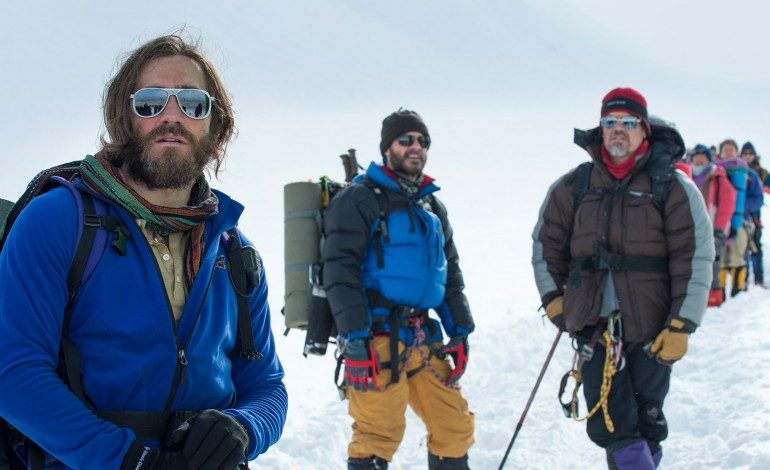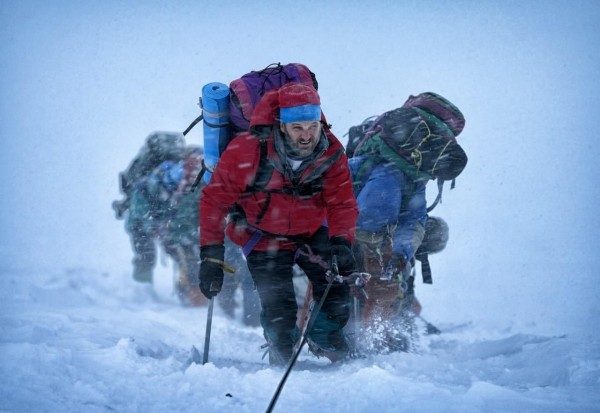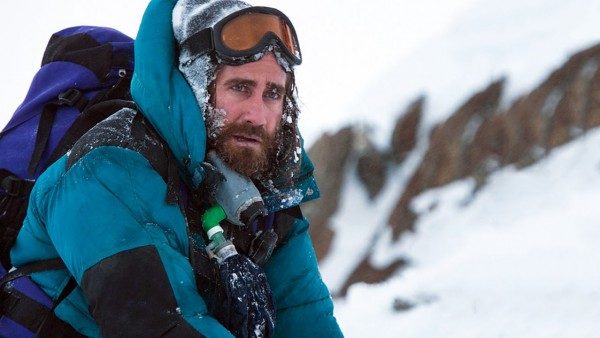

In May 1996, a rogue storm struck Mt. Everest, resulting in the deaths of eight climbers. Jon Krakauer’s non-fiction novel Into Thin Air offered a first person chronicle of the event; he was among the many who climbed the beast of Everest that fateful spring. The action spectacle spectacular Everest isn’t exactly (or entirely) based on Krakauer’s book (though the author is featured as a character), however it charts the same, ultimately sad tale in dizzying, blistering, often dazzling 3-D fashion.
Turning this devastating real-life event into an all-star disaster epic meant to be projected in the largest movie houses erected might seem gauche, opportunist, even a tad insulting. It probably is, but there’s an agreeable showmanship on display in Everest that settles qualms over crass commercialism and Icelandic filmmaker Baltasar Kormákur (who previously captained the trashy pulp pieces 2 Guns and Contraband) goes to great lengths to make his audience feel right on the precipice of the most isolating and astonishing peak of the world. For Everest itself- parts of the film were shot in Nepal and in the Italian Alps- is the real star of the picture and there’s an evolving sense of danger, dread and exhilaration, if never quite a beating human heart, as the movie reaches its summit.
There’s a sleek dynamism to Salvatore Totino’s cinematography as the film tracks mountaineers crossing makeshift ladders across icy crevasses and hanging within an inch of their lives strapped to little else than ropes and each other. The majesty of Everest is the majesty of Everest and there’s little use for the picture at all unless it’s being viewed in grand movie palaces with state of art sound systems and fine 3-D accommodations.
Throughout, a thought may linger: What in earth would possess someone (in the case of Everest, mostly men) to take on such an expedition? The answer to that question is barely hinted if not entirely brushed aside as psychology has little room in the seemingly cobbled together-over-many-drafts screenplay credited to William Nicholson (Unbroken) and Oscar winner Simon Beaufoy (Slumdog Millionaire). The adventurous crew is headed by experienced climber Rob Hall (Jason Clarke, Zero Dark Thirty). Hall, the owner of Adventure Consultants, leads treks up the mighty and beastly Everest for both the most seasoned and less experienced climbers, that is if one can afford it. Hall is represented honorably, with a soft but fatherly touch to his crew, something of which is played well with an actor as coolly imposing as Clarke. As a counterpoint, Jake Gyllenhaal plays a rival mountaineering company head who adopts a more Darwinian approach with his clients, with the snide, if sensible thought that not everyone is suited to tackle a beast like Everest in the first place. Early scenes of Everest show a bustling base camp, suggesting potentially how en vogue such expeditions were in 1996.
Hall’s crew includes Josh Brolin (Inherent Vice) as wealthy Texan rube Beck Weathers (so perfect a name you couldn’t make it up even if you tried), a veteran mountaineer numbed when at sea level and John Hawkes (Winter’s Bone) as Doug Hanson, an adventurous man from a significantly lower tax bracket hoping to accomplish something yet after a failed attempt at Everest the year prior. The lone female member is the Japanese climber Yasuko (Naoko Mori), a woman whose climbed six of the top seven peaks in the world and is angling for a perfect streak- as such, she’s given really only two or three lines of dialogue. Michael Kelly (House of Cards) plays Krakauer, a client covering the expedition for Outside Magazine; he’s the one who asks the fateful question the night before the crew is slated to summit: “Why?”
“Because it’s there,” the group shouts in the tandem. The response feels like a put-on considering it’s mostly left to hang but further asserts the filmmakers have little interest in their characters whatsoever. While various members of the sprawling cast are given little asides from time to time (particularly in the slow-moving first hour of the film) to exhibit some personality flourishes. For instance- Clark is noble, Gyllenhaal is flaky, Brolin is arrogant, Hawkes is thoughtful, etc. Yet, it’s increasingly difficult to gather much in the way of an emotional connection as the movie moves onward and things start to go horribly wrong. For instance, everyone is so hidden under numerous layers of jackets and gear that it makes all the characters physically interchangeable from one another. Everest picks up and turns into a fairly exciting action film but it stops just short of become an emotionally involving one.
Time and time again, Kormákur has to turn his camera away from the action atop the mountain to make sense of the events actually going on. The reactions mainly consist of the worried women at base camp and at home- Emily Watson (The Theory of Everything) plays the camp’s den mother and co-runner of Adventure Consultants, Elizabeth Debicki (The Great Gatsby), the crew’s physician while Keira Knightley (The Imitation Game) and Robin Wright (House of Cards) drew even shorter straws as the doting wives forced to stay glued to their telephones. That’s a lot of on-screen talent on display, so much so the movie sort of functions as a modern day The Poseidon Adventure minus the camp and pithy one-liners. The lack of character development aside, Everest is still a formidable visual beauty throughout and marks a fine, if stubbornly middle-of-road action adventure.
Verdict: 3 out of 5
While Everest doesn’t match recent survival tales like Gravity or 127 Hours on terms of formal ambition or visceral acting showcases, the movie propels a nicely calibrated sense of danger and exhilaration. Director Kormákur and cinematographer Totino bring a rigorous and nearly propulsive in-your-face experience atop one of the great beauties of the world. There’s a proper sense of grandeur and foreboding doom at nearly every step of the way. That sense would have been even grander and more emotionally powerful had we gotten to know a few of the characters a little bit more.



